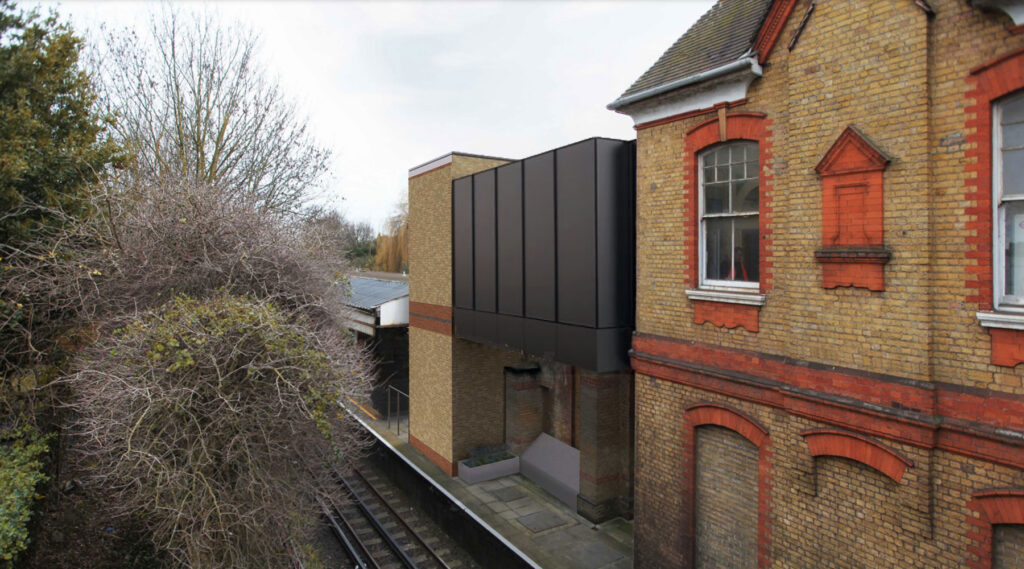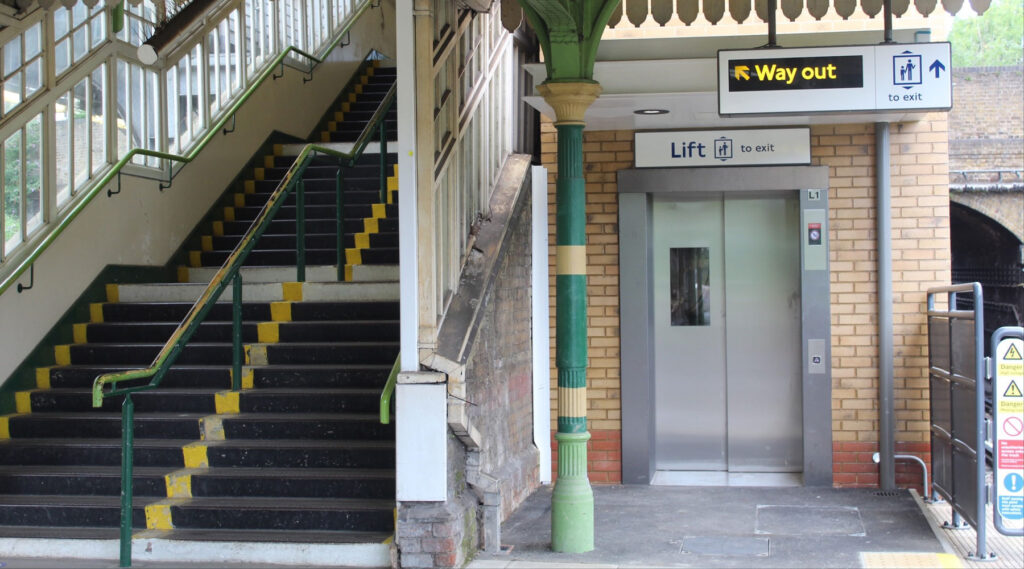Wimbledon Park tube station on the District line has become the 86th station on the London Underground to go step-free after a new lift came into use on Monday.
The station has a single island platform between the two railway tracks, and leads up a staircase to a very small ticket office building that looks more like a very small cottage, described as being built in the “Dutch classical style”.
To squeeze a lift into the site meant extending the back of the ticket office a bit in a new steel structure, and then adding the lift shaft down to the platform level.
Wimbledon Park station is now served by one lift which provides access to the central platform for both east and westbound District line services. The line is accessible from street to platform, with boarding ramps available for use by station staff to assist customers who need them.
The lift was originally expected to be opened in March 2020, but we all know what happened last year to delay construction.
A niggle is that as you go into the station, the existing wide access ticket barrier is on the right side of the entrance, whereas the lift is on the left side. That couldn’t be changed without rebuilding the whole gateline as well, but there’s plenty of space between the lift and the wide ticket barrier that it’s not a significant issue.
A bit of history
The station opened on 3rd June 1889 as part of the London and South Western Railway which, starting on 1 July 1889, ran its own trains over the line from a connection at East Putney to its Clapham Junction- Barnes line.
Mainline rail services through Wimbledon Park were ended by the Southern Railway on 4 May 1941, although the line remained in British Rail ownership until 1 April 1994 when it was transferred to London Underground.
Although a tube station, three South Western Railway services run to and from Waterloo along this line in the early hours of the morning. There are some occasional empty trains and diversions through the station. That makes the station unusual in that you can be waiting for a tube train, and an SWR train will pass through instead — without stopping though.
Other stations
Elsewhere, work is continuing at Osterley, as well as at Harrow-on-the-Hill and Sudbury Hill, all of which are scheduled to become step-free before the end of the year.










I noticed, watching the Secrets of the London Underground, (Episode 4: Euston and York Road) that York Road station was, unusually for the time, built with lifts that went down the platform level.
IF they ever managed to re-open the station (which would be useful for that now residential area) it could easily have step-free access.
For some reason – I don’t think Siddy Holloway mentioned it – most station lifts lead to stairs.
There are no plans to reopen York Road station
https://www.ianvisits.co.uk/blog/2018/02/18/reopening-the-piccadilly-lines-disused-york-road-tube-station/
Indeed, thus “IF” in capital letters. I was just making a point how design decisions of the past make installing accessible lifts so .. expensive.
My guess is that platforms and low-level lift landings were separated by stairs in order to disperse any crowd of passengers from an arriving train.
There are no stairs between the platform and the lift.
It’s rather more basic than that. For legal reasons, most early tube running tunnels were built under roads. Most roads were too narrow to accommodate two running tunnels and lift shafts between them.
Additionally, sinking lift shafts and building stations in the middle of a road was much less practical than acquiring a station site on one side!
Thus lift shafts usually went to a lower concourse under a station site to the side of the road with passages/bridges and steps down to reach the platforms directly underneath.
Unusually at York Road, AIUI the streets and station site were such that it was possible to sink the lifts directly between the running tunnels. I don’t think anyone involved in the 19th century would have denied that it would have been great to have this configuration everywhere, but it just wasn’t possible.
The station and the Wimbledon Putney Bridge line are the remnants of a grander scheme. The nominally independent, but Metropolitan District Railway-supported, Guildford, Kingston & London Railway was to have run from a terminus at Pelham Street, South Kensington, to Guildford. The route would have been broadly parallel with the SWR line between Wimbledon and Surbiton, where there would have separate stations.
The proposal had the support of people in Kingston and most of the local landowners, but was opposed by conservationists (they did exist in the 1880s!) worrried about the effect of the tunnel on Wimbledon Common’s drainage, the National Rifle Association and, most of all, the London & South Western Railway, which rightly saw it as a big threat to its growing commuter traffic from Surrey. The LSWR was even afraid the line might be extended to Portsmouth.
So, after 40 years of snubbing requests from Cobham, Bookham, Leatherhead, Ripley and district for a railway, the LSWR suddenly became interested in the area and in November 1881 proposed a rival scheme.
What we have now is an amalgamation of the two schemes: the LSWR built its ‘New Guildford Line’ via Cobham (actually Stoke D’Abernon – the station is 2 miles from Cobham!) from just west of Surbiton station, and then made the link from Wimbledon to Putney Bridge. The duplicate route between Wimbledon and Surbiton was abandoned, as was the Pelham St terminus. All the fiddly little branches to Bookham and Leatherhead were replaced by a simple link from Leatherhead to Effingham Junction. Land bought for the GKLR station at Surbiton was developed for housing, and the spacious villas in South Bank became upmarket housing for LSWR directors and senior staff.
The amalgamation made more sense on the map and avoided what at the time would have been wasteful duplication, but the ‘country’ end of the line didn’t go near any of the villages, and today, with the main line out of Waterloo said to be at 98% capacity, that duplicate line beyond Wimbledon Park would have been a godsend.